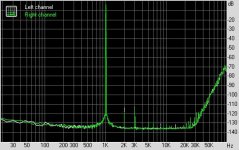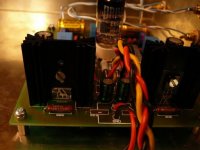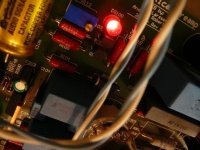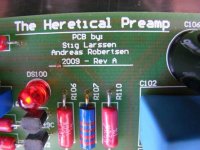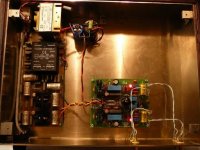Yes, I fixed the negative grid voltage and used the servo to the reference node of the HV regulator. It worked OK, but there's more interaction with the servo than when the servo output is fed to the grid via the 10M. The offset is still low with B+ control, but because of the necessary decoupling, it tends to wander a bit.
The divider of 10M/1k is the reference standard for servo isolation. Beat that and you've got a better topology.
The divider of 10M/1k is the reference standard for servo isolation. Beat that and you've got a better topology.
SY said:Yes, I fixed the negative grid voltage and used the servo to the reference node of the HV regulator. It worked OK, but there's more interaction with the servo than when the servo output is fed to the grid via the 10M. The offset is still low with B+ control, but because of the necessary decoupling, it tends to wander a bit.
The divider of 10M/1k is the reference standard for servo isolation. Beat that and you've got a better topology.
Hi SY, I don't know your test circuit, but if you get additional 'non integrated' gain, you'll get some trouble i.e. 'more interaction'.
BTW I think you know my topology. 😉
http://www.diyaudio.com/forums/attachment.php?postid=1713343&stamp=1232013864
Still looking for a practical output stage for RIAA 2007 ?
Still looking for a practical output stage for RIAA 2007 ?
Well, with the divider ratio I gave (which is very conservative), you knock down the integrator AC contribution by 80dB while gaining the full DC benefit.
SY said:Well, with the divider ratio I gave (which is very conservative), you knock down the integrator AC contribution by 80dB while gaining the full DC benefit.
schematic #16
 The op is a non inverting amp. If you short the cap, gain is still unity.
The op is a non inverting amp. If you short the cap, gain is still unity. 
May I ask what you people are partnering these designs with? And are you happy with the sonics?
In my experience, cathode followers do suck, and it is not due to incompetent design. Maybe it's the 100% feedback, but I am probably getting some of you stone-throwing already against me.
I see other vices, like LM317s and discrete regulators with tons of feedback.
Let us not disregard the mortal effect of current sources on tube cathodes. This all is the result of calculated experiments, not pseudosience, not re-iteration...
Though I have not built it, my guess is that this should be one of the most dull, artificial and hard-sounding designs out there. Only the transformer would help, but not be quite able to save the day.
Really sorry SY.
In my experience, cathode followers do suck, and it is not due to incompetent design. Maybe it's the 100% feedback, but I am probably getting some of you stone-throwing already against me.
I see other vices, like LM317s and discrete regulators with tons of feedback.
Let us not disregard the mortal effect of current sources on tube cathodes. This all is the result of calculated experiments, not pseudosience, not re-iteration...
Though I have not built it, my guess is that this should be one of the most dull, artificial and hard-sounding designs out there. Only the transformer would help, but not be quite able to save the day.
Really sorry SY.
Last edited:
SY ...D.Self did this way back in the 1970's. Youv'e done what I've done although my fault I didn't publish it. The only difference between designs is I use both ECC88 sections for an even lower o/p Z and a lower grid leak of 2M.
Your tests don't specify using an output load.. Or do you ?
The bad news is I still use a wacker 56uF low leakage cap (parafeed)with a mumetal 2:1 tranny for balanced o/p. I cannot bear the slightest mV offset and Can't get away from this and use a mute circuit. It sounds better with the parafeed transformer than without.The conversion into a balanced o/p using the other half ECC88 spare section is simple. In either case the performance is exemplorary, but of course the noise becomes 6dB worse off. Have you tried injecting a higher signal voltage: +20dBu as I do and measuring on load ?
Where the work really starts for lowest thd is the preceeding stages, esp if an active tone control (Baxandal) is used. All exciting work.
Your tests don't specify using an output load.. Or do you ?
The bad news is I still use a wacker 56uF low leakage cap (parafeed)with a mumetal 2:1 tranny for balanced o/p. I cannot bear the slightest mV offset and Can't get away from this and use a mute circuit. It sounds better with the parafeed transformer than without.The conversion into a balanced o/p using the other half ECC88 spare section is simple. In either case the performance is exemplorary, but of course the noise becomes 6dB worse off. Have you tried injecting a higher signal voltage: +20dBu as I do and measuring on load ?
Where the work really starts for lowest thd is the preceeding stages, esp if an active tone control (Baxandal) is used. All exciting work.
Rich, the load was the 10k input of my sound card. I measured at a sufficient voltage to clip any power amp I have in house (2.5V, if memory serves, haven't read the article in a while).
hollow, yes, I'm certain that I'm deaf. Clearly I need to work on a design that doesn't have vanishingly low noise and distortion, coupled with low source impedance.
hollow, yes, I'm certain that I'm deaf. Clearly I need to work on a design that doesn't have vanishingly low noise and distortion, coupled with low source impedance.
May I ask what you people are partnering these designs with? And are you happy with the sonics?
In my experience, cathode followers do suck, and it is not due to incompetent design. Maybe it's the 100% feedback, but I am probably getting some of you stone-throwing already against me.
I see other vices, like LM317s and discrete regulators with tons of feedback.
Let us not disregard the mortal effect of current sources on tube cathodes. This all is the result of calculated experiments, not pseudosience, not re-iteration...
Though I have not built it, my guess is that this should be one of the most dull, artificial and hard-sounding designs out there. Only the transformer would help, but not be quite able to save the day.
Really sorry SY.
Could I suggest that you start a thread and post one of your designs?
I understand we are sensitive to different aspects of sound reproduction.
I would be much more interested in what you consider good than your opinions on another design that you have never heard. I am sure you have something positive to contribute? 😉
Doug
Doug,Could I suggest that you start a thread and post one of your designs?
I understand we are sensitive to different aspects of sound reproduction.
I would be much more interested in what you consider good than your opinions on another design that you have never heard. I am sure you have something positive to contribute?
If you look around the site, you will see part of my work. I can't say I can claim a position in the hall of originality, but I have built an Electrocompaniet clone, an 6H30 SE to balanced line stage, a 6SN7 line stage, a Conrad-Johnson RIAA pre, an Elektor power amp, various not much unconventional solid-state pre- and power amplifiers, plus a ton of RF projects.
But must we talk about these?
Last edited:
Also, I myself said that I have not listened to the heretical pre, but I think that this should not stop me from expressing an opinion based on whatever experience I may have gathered so far.
May I ask what you people are partnering these designs with? And are you happy with the sonics?
In my experience, cathode followers do suck, and it is not due to incompetent design. Maybe it's the 100% feedback, but I am probably getting some of you stone-throwing already against me.
I see other vices, like LM317s and discrete regulators with tons of feedback.
Let us not disregard the mortal effect of current sources on tube cathodes. This all is the result of calculated experiments, not pseudosience, not re-iteration...
Though I have not built it, my guess is that this should be one of the most dull, artificial and hard-sounding designs out there. Only the transformer would help, but not be quite able to save the day.
Really sorry SY.
This opinion owes more to psychology than reality.
This opinion owes more to psychology than reality.
or perhaps psychiatry? 😉
In my experience, cathode followers do suck, and it is not due to incompetent design. Maybe it's the 100% feedback, but I am probably getting some of you stone-throwing already against me.
I see other vices, like LM317s and discrete regulators with tons of feedback.
Let us not disregard the mortal effect of current sources on tube cathodes. This all is the result of calculated experiments, not pseudosience, not re-iteration...
Source? Data?
Source? Data?
While CFs can have problems - asymmetrical slew behaviour for example - the cathode current source issue is particularly odd in this application. The cathode normally sees the amp's input R, usually 47kohm at audio frequencies, as the predominant load.
Unfortunately, I have stopped giving free psychiatric lessons, but before paying a visit to my office, may I suggest you try for yourself to hear the difference between a similarly engineered CC and a CF stage. Been there, done that. Power supplies? I have used current sources and LM317s on tube cathodes and they are nasty.
I won't go into the details because it is boring, but instead of stone-throwing may I suggest to some to learn to hear other people's opinion.
I won't go into the details because it is boring, but instead of stone-throwing may I suggest to some to learn to hear other people's opinion.
if the details are so boring, you have little room to critcise a designer who gives the details. Integrity score:0 Thanks for your input, I value it as much as I can given the detail offered...
TVC on the input.
Sounds great. Compared to TVC alone just no question. Everything is better.
Compared to f.eks a TVC-6j5-trafoe outout pre its far more linear and a lot more "rich". Low frequency improved, and a much more comfotable listening to. Best we have heard - maybe. Still need to do more testing.
Sounds great. Compared to TVC alone just no question. Everything is better.
Compared to f.eks a TVC-6j5-trafoe outout pre its far more linear and a lot more "rich". Low frequency improved, and a much more comfotable listening to. Best we have heard - maybe. Still need to do more testing.
Attachments
- Status
- Not open for further replies.
- Home
- Amplifiers
- Tubes / Valves
- A Heretical Unity Gain Line Stage part III
